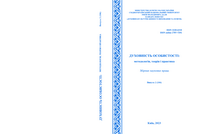APPROACHES TO EVALUATING THE TRANSFORMATION VECTORS OF DISPLACED UNIVERSITIES
DOI:
https://doi.org/10.33216/2220-6310/2023-106-2-214-225Keywords:
displaced universities, approaches and vectors of transformation, modular approach, end-to-end coordinationAbstract
The article examines and analyzes promising vectors and approaches to the systemic transformation of relocated universities in the format of modern challenges under the educational program 201 “Agronomy”. The subject of the study is the transformation factors of the educational process based on the principles of end-to-end coordination. The research was carried out as a part of the development of the innovative development strategy of the Department of Agronomy and Forestry of Volodymyr Dahl East Ukrainian National University (SNU/EUNU). The object of research is the main factors of building integral systems according to the modular principle. It was established that when dividing by functional directions in individual plans for educational program 201 “Agronomy”, the share of educational work is close to 23.8%, methodical work to 34.0%, scientific work to 3.9%, organizational work to 36.7% and professional development up to 1.6%. Functional and pragmatic in the organization of the educational process is the observance of algorithms A4 (Intelligence-Information-Innovation-Investment) and A6 (Analyticity-Actuality-Adequacy-Adaptability-Emphasis-Activity). According to the SMART approaches of problem statement and SWOT analysis, the application of the Pareto 80/20 rule is justified. For educational program 201 “Agronomy” for masters at the initial stage of system creation, a 3-module level of structural organization with coverage of 21 factors is sufficient, with a potentially possible 5-6 module level with coverage of 33-39 factors. For simpler local problems, it may be justified to use semi-modules, for which 1 semi-module can analyze 8 factors, 2 semi-modules - 13, 3 semi-modules - 18, and 4 semi-modules - 23 factors. When forming the system, it is important to ensure a 6-element level of factor clusters and the choice of 3 connection points between modules or semi-modules.

